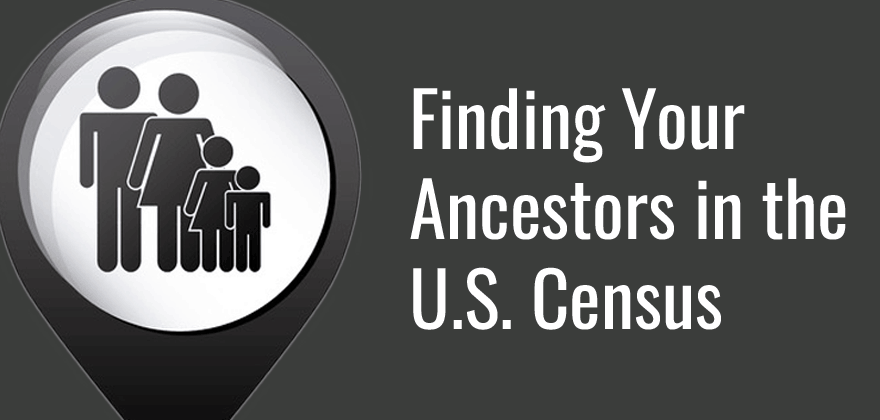The United States Federal Census is a tool that every researcher will have to master in order to complete a well-researched family history.
It is helpful to think of Census records as supplements to other records, and a way to create new lines of research. Though they can certainly help point you in the right direction, more research is almost always needed to verify and complete a family relationship.
Federal census records are probably the most popular, and easiest to use records amongst beginner genealogists.
Whereas most records cover a single individual or family, Census records give us a much broader picture of an entire geographical area.
Whether you’re just getting started in genealogy or an advanced researcher, Census records are something that you absolutely must know how to use.
Brief History of the Census
The Census first began after the American Revolution in 1790 under Secretary of State Thomas Jefferson.
Since then there have been twenty-two federal Censuses with the current Census being taken in 2010.
The next one is scheduled to happen in 2020, and for the first time will largely be taken via the Internet.
The principal purpose of the Census is to divide seats in the House of Representatives by population.
Occurring every ten years, the Federal Census is constitutionally mandated, and was originally used for population data in order to apportion Congressional districts.
They have become one of the most important tools in genealogical research as well, especially after 1850, a time in which many measurements were added to the Census for other important statistical data.
Early Censuses only recorded the name of the head of household, and a count of all other household members.
The first nine Census were conducted by U.S. Marshalls who had to provide their own paper and sort the data in whatever way made sense to them. There wasn’t a standardized format until 1830.
Throughout the years as our nation evolved it’s needs and interests became more and more detailed and complex.
The Federal Census became the tool with which the government recorded employment rates, housing statistics, and relatives to the head of household.
It developed into a way to capture vital statistics, and relevant data about the people of America. These documents often include the ages, birthdates, and relationships of everyone in the household, giving us an insight that few other records can.
Read our complete guide to census records.
Type of Data Captured
The data tabulated on the Federal Census has changed throughout the years for the most part, with only a few exceptions remaining the same.
You can always expect to see your ancestor’s name and the place in which they lived at the time the Census was taken, but Censuses after 1850 will almost always have at least some of the information listed below.
In 1810 value of goods and products was covered for the very first time. Later, statistics about fisheries would be established.
In 1850, data concerning taxation, church affiliation and primary employment were all new questions, providing the government with unique insight into the daily lives of everyone living in the nation.
Some of the information that you can expect to see on Census records before 1940 and after 1850 is listed as follows:
- Date and place of birth
- Date of marriage and name and age of spouse
- Number of children, names and ages
- Immigration and naturalization
- Military service
- Property ownership
- Employment information
This is a wealth of information about an ancestor, and can sometimes make the difference between an inferred relationship and a proven one, depending on the quality of data captured.
However, there are some situations in which this information requires more research, and mistakes are not uncommon.
There are few things more satisfying then finding out your ancestor’s occupation, and other details about their lives such as immigration, and the names of their family members.
Military service is also a commonly researched vital, either for personal satisfaction or for membership to genealogical related groups.
Other vitals that are sometimes captured on Federal Census records include:
- Place of parents birth
- Name of parents
- Literacy
- Physical qualities such as race
- Value of home if owned
- Whether or not they attended school
- Value of personal estate
Limitations
In general, you need to know your ancestor’s name and approximately where they lived.
Sometimes if you don’t know the exact location, searching by county or even by state can work, even though it typically returns more results that have to be filtered through.
This can create problems for researchers, but can also reveal more information that is relevant to your search.
The Federal Census records are rife with spelling errors, and often times birth dates and marriage dates are approximate. It all comes down to the quality of information that was recorded.
Other than the 1940 census, the informant of the information is unknown which is something we have to consider in our analysis.
Was your ancestor’s birth year off by five years because they weren’t home so the enumerator asked a boarder or a neighbor to estimate?
Another thing to consider is that even though the Census often records female spouses, it almost never includes the spouse’s maiden name. Read this article on how to find a maiden name from a married name.
The 11th Census of 1890 was destroyed by fire in 1921. All but one percent of the records were destroyed and the remaining population schedules were later converted to microfilm. Read more about 1890 census substitutes.
Unfortunately, things like this do happen, so it is vitally important to keep good records and documentation for yourself.
In order to prevent the release of potentially sensitive information about individuals the U.S. government decided to use a 72-year privacy rule.
This rule allows researchers to view data collected from 1790 to 1940 census records.
The 1950 Census data will be available in 2022. The reason they chose 72 years is because at that time it was longer than the average female lifespan.
There is a fair amount of human error at hand as well, due in part to the fact that clerks worked to tabulate all of this information and simply sometimes misread the document, or misspelled the supplied information.
Enumerators were usually locals to the area and were expected to have a general understanding of their neighbors.
How to Use Census Records for Research
A good plan to start is to organize the information you already have and list some research questions that you want to satisfy.
Chances are good that you already have some working knowledge of your lineage whether it is in the form of family photos or old birth certificates.
Begin with your grandparents, or whoever else you have the basic information on.
Start small with the information you have. Sometimes when too few search results are yielded it is because the information is too specific.
For example, if you believe that your ancestor was born in 1850 then use a date range 1848 and 1852 to account for possible enumerator errors.
Begin searching the name index. Make sure you record the page number, enumeration districts, certifications or other pertinent information related to the page that your ancestor appears on.
Compare the information on the Census to the information in your records, if any.
Be sure to check the previous and following few pages as well because other ancestors who might have lived nearby may be listed as well.
Some Censuses are easier to search through than others. Work at them one at a time.
Jumping back and forth can make it easy to get confused. It is also a good idea to start with the most recent Census, which at the time of writing is the 1940 Census.
If you don’t find your ancestor, check another index. Be sure to check the entire county or town because elderly parents or married children may be living somewhere close by.
Examine all families who have the same surname in the area, and make notes.
Even if you don’t know who is who at the time, there is a good chance that you will later on, and you don’t want to keep repeating the same research steps over and over again.
Sometimes browsing the Federal Census can provide clues that otherwise might not be apparent.
The best advice for browsing Census records is that the smaller the number of images being examined at one time, the more successful the researcher typically is.
If the first or last name of your ancestor is frequently misspelled or mispronounced it may be a good idea to use different spelling variations when researching.
It can eliminate confusion and misinformation about your ancestor from the beginning if you are aware of the human error factor involved.
Putting it All Together
Federal Census data helps provide us with starting points, basically the data we need to find other records.
Using birth dates and ranges found on Census records we could then search birth indexes, social security applications, the possibilities are almost endless.
The most important thing that cannot be stressed enough is good record keeping.
Without detailed notes about where data can be found and the quality of the data, then the records themselves aren’t of much use at all.
Whether you use a notebook or complex genealogical software is entirely your preference.
Using and viewing digitized records is not nearly as difficult as viewing microfilm, but sometimes the microfilm holds the answers we need that cannot be found anywhere else.
If this is the case in the course of your research, remember to be patient and take small steps.
The same applies to large research volumes at the local library, or at the public records office.
Other Notes, Controversies, and Research Tips
If your family moved during the Great Depression of the 1930’s then it may be even more difficult to discover where they were originally from.
One of the unique things about the 1940 Census was that it captured residency data for each individual on 1 April 1935.
You may need to search further into documents from the 1940 Census to find out where your ancestor maintained residency during that time.
The Census Bureau estimates that during the 1970 Census over six percent of African Americans were not counted.
Minority groups were statistically less likely to be counted during that time. There is also controversy surrounding sampling methods and the accuracy of the current standard.
Be certain to take this into account if you are having trouble locating a particular ancestor.
Always be sure to study the original image of the Census, because there can be details on it that were not included in the transcription or digitization of the record.



